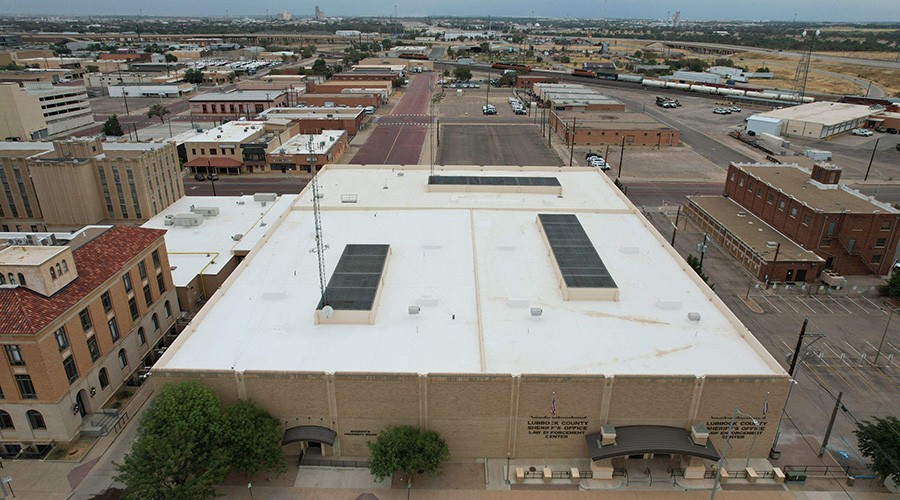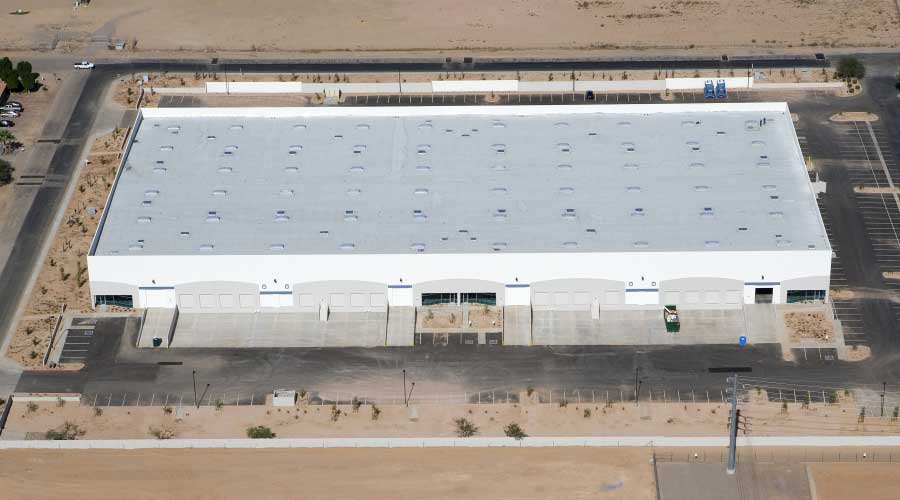Don't Cut Roofing Corners
Value engineering on a roofing project may help the budget, but beware of cutting critical aspects of design, installation and maintenance
In a perfect world, every building would have a top-of-the-line roofing system designed to last 20 years or more. The reality, of course, is that decisions about the roof are subject to budgetary pressures that prevent facility executives from selecting the best long-term choice for a building.
Sometimes the way a building is used means that it doesn’t need an expensive roofing system. For example, temporary buildings’ short life spans probably wouldn’t require high-end roofing systems.
Other times, it does: If the building houses a mission-critical facility where a leak would cause a catastrophe, it probably isn’t wise to value engineer the roof, regardless of budget.
Many times, though, the budget simply doesn’t allow for high-end systems. And that’s when value engineering becomes a necessary strategy. Emergency replacements may force facility executives to make do with resources available at the time. Or, with new construction, funds for the roof are cut to allow additional money to be spent on more visible elements of the building.
“The roof is out of sight out of mind,” says Ric Vitiello, president of Benchmark Services, a roof consulting firm. They design the roof on the cheap. They cut the budget on the roof before anything else because they want brick that costs more money.”
Whatever drives the value engineering process, facility executives must take great care in considering the design, installation and maintenance of a more economical roofing system. Even with a less-than-ideal roof, facility executives can take several steps to make sure that it’s a roof that works well for the building.
“The roof is the fifth wall,” Vitiello says. “It is the most important because if you don’t have that fifth wall, you just have a cave with a big hole at the top. What smart caveman would live in a cave with a hole in the top?”
Good Design
When it comes to selecting a new roofing system, facility executives should heed the advice of qualified designers and consultants.
“During the initial design stage, listen to the consultants and listen to the contractors. You’ll get a lot of good ideas,” Vitiello says.
Consultants may discover that the planned roofing system isn’t in the owner’s best interest. “They might suggest something cheaper or with a longer warranty at no expense,” he says. “In the end, you’ll have a better roof for the building.”
Beyond selecting the designer, some corners simply can’t be cut.
For instance, building up a roof’s slope should be addressed in the design phase, says Burton J. Karp, a roofing advocate and consultant. The design should call for slope build up with the deck rather than “building up the thickness of the insulation to create slope.”
If a contractor has to spend most of the day laying down insulation to build slope, that leaves less time to install the actual roof membrane.
Dealing with existing moisture is another design issue that can’t be ignored, no matter how tight the budget, says Bruce E. Kanter, managing member with Dansky-Kanter Roofing Consultants.
If a roof has failed and water leaks into the insulation beneath the deck, a new roof can’t be installed until the underlying moisture has been removed or dried out. Laying a new roofing system over a damp deck can conceal structural problems.
“One place people try to cut corners is to install a new roof over the existing roof,” Kanter says. “If you have moisture and install a watertight membrane over the old roofing system, it will accelerate deterioration of the new roof system.”
In extreme cases, the roof can even collapse.
Choosing the System
Next, the facility executive and designer must settle on roofing materials. While less expensive systems can perform well in some applications, it’s important to do the required due diligence during product selection. One key step is considering the characteristics of the building itself, Kanter says.
“What is the amount of movement the membrane is going to be subjected to? Some membranes are more flexible than others,” he says.
Also, some membranes are less tolerant of grease or chemicals that may originate within the building. For example, grease causes rubber to deteriorate. Chemical vats from various manufacturing procedures could have the same effect on other kinds of roofing materials, Karp says.
Then there is the weather. Geographical location of the building and the weather conditions the roof is subject to are important considerations, as are the temperature fluctuations the roof will be exposed to.
“A roof that works well in Arizona might not work in Minnesota or New England,” says Karp. “You need to take into consideration snow loads, heat, hail damage and how much rain the area gets.”
In addition to geography, the time of year the roof is installed should be considered in the design. Some materials are more affected by heat and cold than others. “Adhesives need warmer weather. They don’t set well in winter,” Karp says.
In the case of built-up roofs, cold tar pitch doesn’t flow as well in extreme weather. If it’s too hot, the tar will be too thin. “Consistency is very important,” he says.
Meanwhile, roofs subject to high foot traffic have different requirements than roofs with no foot traffic. Pedestrian traffic on the rooftop, whether from building occupants who use the space as a break area or from trades, such as HVAC technicians, will cause wear and tear on the membrane.
“With respect to the quality of the roof, you must take into consideration the amount of traffic and the mechanicals on the roof,” Kanter says. For example, a single-ply membrane can be susceptible to perforation. “A dropped knife or screw driver can punch a hole in it, leading to major problems,” says Kanter.
In some circumstances, the building’s image might be an issue as well.
“Aesthetics might come into play,” Kanter says. “Sometimes the appearance of the finished roof makes a difference to the property owner.”
And finally, facility executives must be aware of insurance requirements and local building codes. Insurance companies or various government agencies may have input on kinds of roofs that can be installed, Karp says.
Experience and Credentials
Even with proper roofing design and materials, an inexperienced contractor can ruin any project.
“Since the 1980s, when single-ply became popular, it has become easier to be a roof installer,” Kanter says. “The equipment is easier to use.”
But while roofing installation may seem easy, one area that is not is making the membrane watertight around flashings and roof penetrations. Those parts of the roof installation often give contractors trouble and separate good contractors from ones that are not so good.
Another reason contractors must be screened carefully and selected based on experience and credentials is that many roof manufacturers will not issue a warranty unless the materials are installed by qualified, approved contractors.
Kanter recommends that facility executives check references. “You want somebody who preferably does nothing but install roofs,” he says.
If the budget permits, experts say it’s wise to hire a roofing consultant.
“In selecting a consultant, you want one with experience in installing roofs,” says Kanter. “You want somebody who understands the ins and outs of installing a roofing system.”
Furthermore, the consultant must be independent. “It’s critically important that the consultant not be affiliated with any roof contractor or manufacturer,” he says. “The consultant should be out there as the property owner’s eyes and ears to see that the owner gets what’s paid for.”
When hiring an outside professional isn’t possible, facility executives should do their own inspections.
The first thing to consider is the timing of the roofing installation in relation to other rooftop installations by the mechanical trades. In new construction, contractors often rush to put the roof down so the building is watertight and ready for finish out, Karp says.
However, many times this installation is premature because other trades such as the HVAC technicians and bricklayers aren’t finished. They end up ruining a new roof before the building even opens. Karp suggests installing a temporary roof that will be replaced once all other exterior work is complete.
If a roof is being re-covered, pay attention to the condition of the deck. It must be clean, smooth, sound and dry before installing the roofing system. Facility executives should familiarize themselves with the ways to properly attach the type of membrane that is being installed. Details, such as the fastening pattern, should be understood.
Kanter recommends facility executives watch the installation to ensure the membrane is properly attached and the flashing is done properly.
If possible, at least hire a roofing consultant part time.
“Let the consultant review the bids,” Vitiello says. “Sometimes it’s not so much what the proposal says; it’s what the proposal doesn’t say. The consultant can read between the lines and see what’s been left out. The roof consultant can make sure that everything is in there that needs to be in there.”
The roofing consultant should also conduct a final inspection to make sure the roof is watertight and the flashing is properly installed.
Maintenance Needs
Industry standards say a roof should be inspected and undergo routine maintenance twice a year, in the spring and the fall. This schedule is even more critical when dealing with roofs that were value engineered.
Catching and repairing previously unreported damage before it causes real harm is another reason for periodic inspection.
One of biggest problems stems from mechanical trades on the roof. “When they’re finished, do a walk through to make sure there’s no damage,” Kanter says.
Typically if the membrane develops a leak, and it’s patched quickly, it’s not much of a problem. But if a leak isn’t repaired and the insulation becomes saturated with water, it becomes a vicious cycle of deterioration, Kanter says. “Get up there on a regular basis and make sure you don’t have minor problems that need to be taken care of.”
Routine maintenance also should include cleaning debris from drains and around rooftop equipment, and making sure there are no blisters or open seams around the perimeter, the flashing or vertical areas. “You want to make sure it is watertight and secured,” Karp says.
To make sure maintenance happens as planned, keep records that include the tasks performed and by whom. Keep a copy of the maintenance book easily accessible so that all notes can be entered immediately, Vitiello says.
Above all else, train the maintenance staff in the correct methods of caring for and repairing the roof, Vitiello says. Frequently, roofs are repaired using materials incompatable with the membrane, which causes premature failure.
“Maintenance people should know how to do emergency repairs on the roof and when to call a contractor,” Vitiello says. “It’s not enough to smear something on to stop the leak. They may or may not have used compatible materials. They may or may not have done a permanent repair. I see roof failures all the time because they sealed off a rubber roof with roof cement, not knowing it will dissolve the rubber.”
Value-engineered roofs can perform well if designed, installed and maintained properly. The trick, Vitiello says: “Don’t let that 50-cent leak turn into a $5,000 leak, which turns into roof failure.”
Lynn Proctor Windle, a contributing editor for Building Operating Management, is a freelance writer who has written extensively about real estate.
Related Topics:











